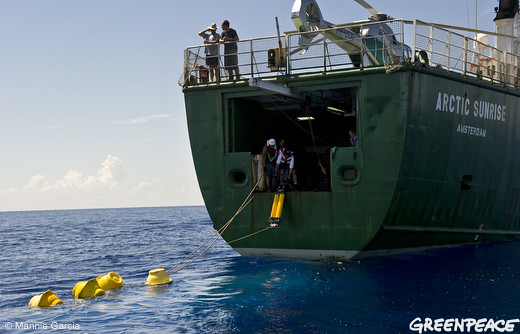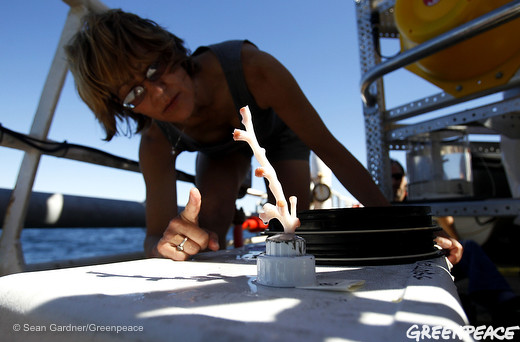 Today, the Arctic Sunrise departs New Orleans for Mexico after completing a three-month research expedition to assess the scope and impacts of the BP Horizon Disaster. Most of the research to date has been funded by BP or the government, so we worked with independent scientists from over a dozen institutions to give us a second opinion.
Today, the Arctic Sunrise departs New Orleans for Mexico after completing a three-month research expedition to assess the scope and impacts of the BP Horizon Disaster. Most of the research to date has been funded by BP or the government, so we worked with independent scientists from over a dozen institutions to give us a second opinion.
We started in Florida. You may remember that early on, it looked like the oil was going to enter the Loop Current and get carried through the Florida Keys. The surface sheen reached all the way to the edge of the Dry Tortugas National Park, Florida’s most pristine reefs. Fortunately, the currents shifted, and Florida’s coral reefs appear to have been spared. We saw no visible oil, but we’ll need to wait for the results of the research we did w/ scientists from Nova Southeastern University to see if there are sub-lethal impacts. As with most aspects of the BP disaster, it will take time for scientists to accurately assess what the damage looks like.
Then we moved out into the Gulf, working with Caz Taylor and Erin Grey from Tulane University to look at impacts to blue crab larvae. Caz and Erin have identified mysterious orange blobs in their samples, which seem likely to be caused by exposure to oil and/or dispersant. If this turns out to be the case, it will be bad news for more than blue crabs: once it gets into the plankton, it will quickly enter the food chain.
We assessed the health of marine mammal populations in the Gulf, conducting surveys led by Sue Rocca of the Whale and Dolphin Conservation Society. We also worked with a consortium of Gulf scientists to use acoustic monitoring buoys to record vocalizations of sperm and beaked whales. NOAA scientists estimate that losing as few as three adult sperm whales to the BP spill could be enough to spell the end for the population in the Gulf, so we are anxiously awaiting the results of this research.
With Rainer Amon and Cliff Nunnally from Texas A&M University, we used some VERY heavy equipment (when we loaded the winch on board, the whole ship listed to starboard) to see how much oil there was in the water and on the seafloor. While more analysis is still needed, it appears that we have identified a substantial plume 300 miles to the west of the Deepwater Horizon site. We also found oil in sediment samples taken from nearly a mile down, which we confirmed were from the BP spill.
Finally, we worked with Steve Ross from the University of North Carolina and Sandra Brooke of the Marine Conservation Biology Institute, using a submarine to investigate impacts to deep sea corals. I was the pilot of the sub, and was happy not to see any visible oil around the corals, which looked like they were in good shape. It will take time to see if the oil has effected their growth rate or reproduction, or if they are more susceptible to disease, but at least for now the news looks good for the sites we visited.
So on the whole, some good news (corals apparently spared serious impacts), some bad news (oil has spread much farther than we realized) and some important results yet to come (impacts to plankton and whales). We will make sure the results are shared with you, and with policy makers in DC. And we will continue to work to ensure that Congress and the Obama administration to learn from this disaster and take steps to prevent it from every happening again. This is an urgent mission, because for now, our oceans remain at risk.
For the oceans,
John H




